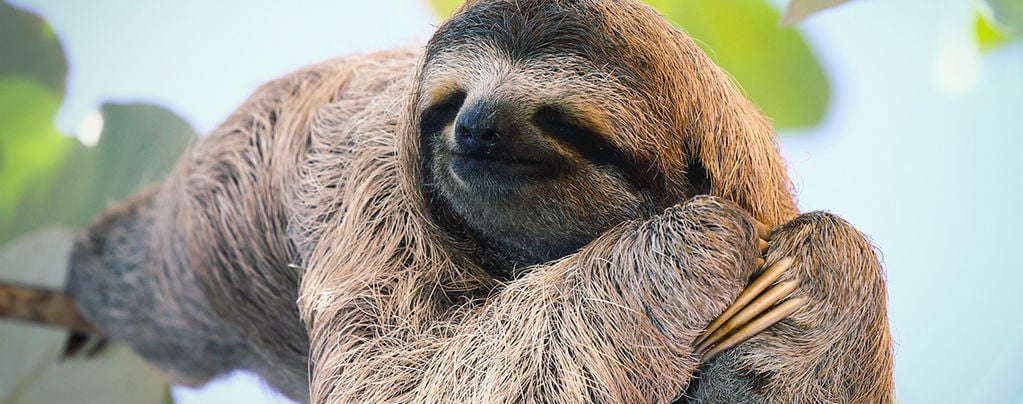
The Secret Behind Spaced-Out Sloths: A Valium-Like Fungus
If you thought sloths couldn’t get any slower, you are wrong. There is an entire species addicted to sedatives. Nature has a strange sense of humour.
Measuring at just 50cm, the Pigmy Three-Toed Sloth is the smallest species of sloth currently known. Other than being tremendously cute (and critically endangered), these little munchkins have one other notable aspect of their lives; they spend it high on Valium – or at least, a Valium-like substance. It explains a lot!
Sloths by nature, are notoriously slow animals, and this particular species is slower than the rest. It was scientist Bryon Voirin who made the discovery and actually noted during his reach how easy the sloths were to catch due to their overly laid back nature.
HOW AND WHY ARE THEY CONSTANTLY HIGH?
This particular species of sloth is only found on Escudo, a small island off the coast of Panama. It is thought that for 9000 years they have evolved to deal with the island’s habitat, acquiring a taste for red mangrove leaves. In fact, it is all they will eat. When put in other trees, scientists observed that the sloths made a bee-line for the nearest red mangrove (as much as a bee-line as a sloth can make!). The thing is, when investigated, it was found the mangrove leaves on the island were infested with a fungus - which is thought to be the culprit for the constant Valium-like high.
The sloths are so spaced out, that green algae and even moths were found living in the fur of one particular sloth.
The revelation first arose when Bryson and his team took EEG brain scans of the sloths to compare them to their mainland cousins. It was found that the slow wave activity they exhibited during sleep was extremely similar to those of people addicted to Valium. Although the idea of drug addiction was dismissed at first, it is now the leading hypothesis, with the team now investigating the Valium-like fungus in much more depth.
If there is any creature on this planet that needs to slow down and enjoy the sights a little more, it is not a sloth!
-
 4 min
31 December 2024
The Diverse Effects Of Kratom
Kratom can energise and lift you up, but it can also bring about relaxation and help you sleep. Interested to find out more about this strange plant? Then keep reading to become acquainted with the...
4 min
31 December 2024
The Diverse Effects Of Kratom
Kratom can energise and lift you up, but it can also bring about relaxation and help you sleep. Interested to find out more about this strange plant? Then keep reading to become acquainted with the...
-
 3 min
26 July 2022
How To Grow Salvia Divinorum
Otherwise known as the “sage of the diviners”, Salvia divinorum is a plant species with hallucinogenic properties. While its beginnings are rooted in Mexican culture, it has garnered huge...
3 min
26 July 2022
How To Grow Salvia Divinorum
Otherwise known as the “sage of the diviners”, Salvia divinorum is a plant species with hallucinogenic properties. While its beginnings are rooted in Mexican culture, it has garnered huge...
-
 3 min
15 October 2018
What Cannabis Does To Your Brain
Cannabis has a complex relationship with our bodies, and interacts with us in many ways. Here is exactly what it does to the brain.
3 min
15 October 2018
What Cannabis Does To Your Brain
Cannabis has a complex relationship with our bodies, and interacts with us in many ways. Here is exactly what it does to the brain.
-
 1 min
19 August 2015
Truffle Biology: Why do Fungus Make Sclerotia?
By getting to know the truffles we so dearly cherish, we develop a much deeper understanding and relationship with them. So here is some info to why they exist.
1 min
19 August 2015
Truffle Biology: Why do Fungus Make Sclerotia?
By getting to know the truffles we so dearly cherish, we develop a much deeper understanding and relationship with them. So here is some info to why they exist.
-
 3 min
4 May 2014
The Peaceful Herb: What Happened to Kava Kava?
Kava Kava has been used recreationally and medically for thousands of years, yet within the last decade it has gotten nothing but bad press. Why did this happen and what are the real dangers?
3 min
4 May 2014
The Peaceful Herb: What Happened to Kava Kava?
Kava Kava has been used recreationally and medically for thousands of years, yet within the last decade it has gotten nothing but bad press. Why did this happen and what are the real dangers?
-
 3 min
9 April 2014
How To Make Salvia Divinorum Extract From Dry Leaves
If you grow your own Salvia plants, why not make your own extracts? With a little kitchen chemistry you can easily produce a potent concentrate yourself.
3 min
9 April 2014
How To Make Salvia Divinorum Extract From Dry Leaves
If you grow your own Salvia plants, why not make your own extracts? With a little kitchen chemistry you can easily produce a potent concentrate yourself.
-
 4 min
7 February 2014
10 Animals That Love To Get High
Humans love to get high - and apparently animals as well. While we‘re alway busy enjoying and exploring new highs, many animals have become proficient stoners themselves.
4 min
7 February 2014
10 Animals That Love To Get High
Humans love to get high - and apparently animals as well. While we‘re alway busy enjoying and exploring new highs, many animals have become proficient stoners themselves.












 United States
United States










